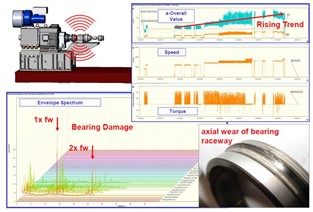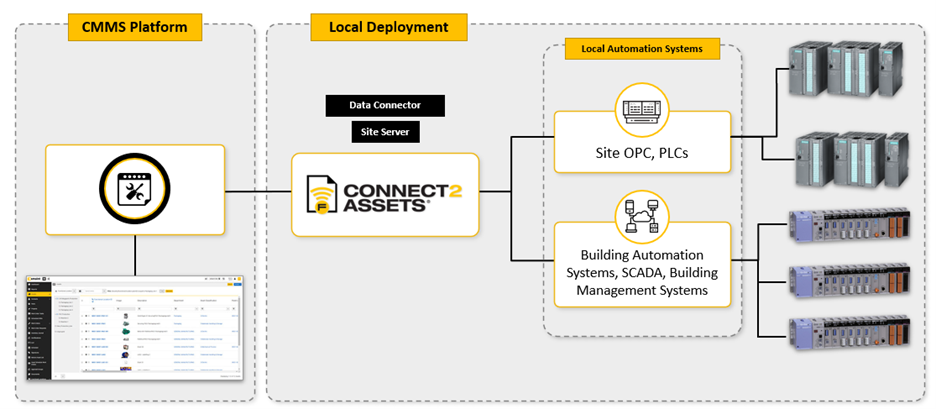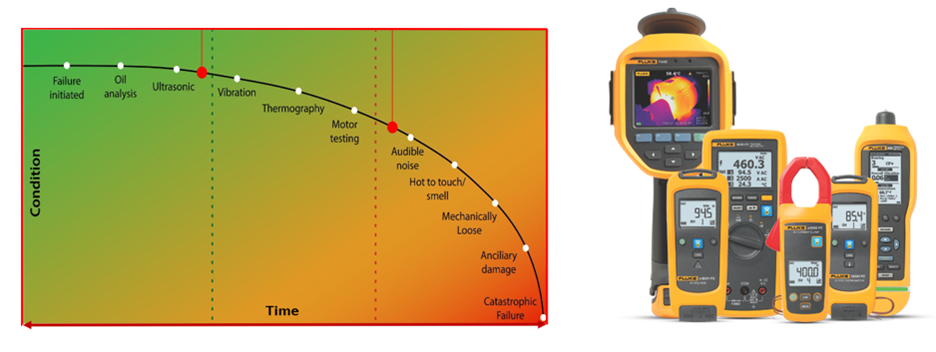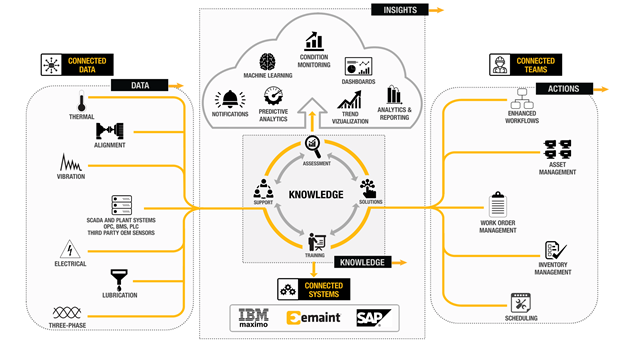While many maintenance and reliability teams conduct route-based inspections on critical assets and do calendar-based PMs on the rest, most are blocked from aggregating all of their operational and asset health data in one place. They may have all of the data in the world between their various systems, but the protocols are all different, and the systems stand alone.
In March 2021, Michael Mills, Mike Ciocys, Brian Harrison, and Jeremy Guo gave a webinar demonstrating that the systems have come together – inside the CMMS.
Part of a series called “Getting more value from your CMMS,” this session focused on “integrations for improving machine health.” Ciocys demonstrated VibGuard online condition monitoring, Harrison demonstrated Connect2Assets SCADA syncing, Guo demonstrated Fluke Connect handheld thermography and vibration, as well as continuous power and vibration monitoring, and Mills demonstrated how eMaint CMMS integrates, manages, and activates the data. The complete webinar is available on-demand.
VibGuard online condition monitoring with eMaint integration
VibGuard is a permanently installed online condition monitoring system that integrates with the PLC via Modbus, MQTT, and PROFINET. The system collects high-frequency vibration, speed, torque/load, and other machine measurements so that the technician or engineer has environmental data a and running history to compare abnormal readings.
According to Ciocys, facilities often implement VibGuard for high-value, non-redundant, complex, mission-critical assets. The primary purpose is to identify failure indicators with enough lead time to take corrective action.
With the first level of data trending, the system easily identifies changes in vibration. Pair that with data from the PLC, such as speed or load, and that trend may align with operational changes. The top of Figure 1 shows the three data points in parallel. As Ciocys asks, “Is the vibration worsening as the machine spins faster?”

Figure 1. Sample Level 1 trend, speed, torque, and spectrum data as measured by VibGuard
From there, look at spatial data at the bottom of Figure 1 to more specifically assess what is happening – in this case, it looks like bearings – which means the problem isn’t related to the motor or gearbox. This insight tells the team to order a bearing and schedule some downtime.
In other instances, you may want to look at the correlating temperature, current, voltage, pressure, fluid level, process stage, or valve position to help determine the root cause. VibGuard brings all of that data in and separates it, adding context, screening it for value, and making it comparable over time.
VibGuard also syncs with eMaint, so that “I can skip the middle man,” as Cioys puts it. “I can have the device take the action of triggering alarms and processing them on the CMMS side as work orders.”
Connect2Assets syncs SCADA operations data to eMaint
As shown in Figure 2, the Connect2Assets system monitors local automation systems, from site OPC and PLCs to building automation systems, SCADA, and building management systems. In the process, it extracts lifecycle data pertinent to machinery and syncs it to the asset health record and work order functions of eMaint. Any asset that is already connected can be monitored, now from an asset health point of view, not just for the sake of operational status.

Figure 2. The Connect2Assets framework linking operational data to the CMMS platform
“In some cases,” says Harrison, “we could be talking about meter points such as pressure or temperature. Or they could be throughput, production, or runtime. Every one of those meter points may have a different level of importance to a specific asset.”
Harrison compares Connect2Assets to a bridge with dozens of onramps. “You can have hundreds if not thousands of vehicles or data points getting on, but only maybe 15 a day may actually have some meaning to asset health.” Harrison calls out the value of knowing everything is OK, knowing what normal operations look like, and having a continuous data stream available to fall back on for root cause analysis when something does change.
Fluke Connect thermography, vibration, and power data direct to eMaint
Fluke Connect is a combination of connected handheld tools and sensors that flow measurement data into Fluke Connect Desktop asset records and, from there, into eMaint. Guo demonstrated how technicians can upload route-based measurements such as thermal images from handheld infrared cameras, data from vibration meters, temperature measurements from digital thermometers, and electrical measurements from digital multimeters and clamp meters into the central dashboard for ongoing trending.
Figure 3 shows some of the Fluke Connect test and measurement tools, juxtaposed against the P-F curve for vibration, thermography, and motor test points.

Figure 3. Fluke Connect handheld measurement tools juxtaposed against the P-F curve for route-based inspection of failure indicators.
The system also supports streaming measurements from three-phase power monitors and triaxial vibration and temperature sensors: “You can use a combination of several tools and collect multiple data points,” says Guo. He advocates using the Fluke Connect software to collate the data by asset and then share it across to eMaint for overall asset management as well as alarms and work orders.
eMaint CMMS at the center
For most maintenance and reliability teams, condition monitoring data, by itself, is incomplete. When an alarm is triggered, and the technician arrives at a piece of equipment, they can typically find the issue at hand and leverage their expertise to remedy the situation. However, the alarm doesn’t provide the date that the machine was last serviced, or what actions were performed, or when maintenance is next due. The alarms don’t know the asset’s history of failure, what parts are needed to complete specific jobs, and whether those parts are on hand.
“The benefit of integrating data with the organization’s system of records for asset management,” says Mills, “is to close these gaps between the systems, to provide a fuller picture to M&R team members, enabling better decisions and more efficient use of resources.”
After all: Every time you open a machine up for maintenance you create risk. Every time you transcribe information, you create an opportunity for error. And every time you send a technician out to investigate an alarm without pre-assessment, you increase the mean time to repair.
Uniting asset health data sources makes sense – it would allow the team to anticipate failures and perform the right actions at the right time. But the concern is: system integrations are often lengthy, costly, complicated, and risky – and who has the time or budget?

Figure 4. In the FlukeReliability framework, data connectors on the left are aggregated and enriched and then integrated into eMaint asset management and work orders.
As shown in Figure 4, Mills demonstrated that eMaint has evolved past those complications. VibGuard, Connect2Assets, and Fluke Connect collect and pre-process the data so that only the relevant pieces get added to asset history or trigger work orders. For more detail, watch the complete webinar on-demand.
Related articles:
Webinar: Get more value from your CMMS -Part II: Integrations for improving machine health
Webinar: Get more value from your CMMS – Part I: Best usage models for business impact and user adoption
Article: Four ways to increase CMMS usage and support continuous improvement
Resource: VibGuard condition monitoring
Resource: Connect2Assets
Resource: Fluke Connect
